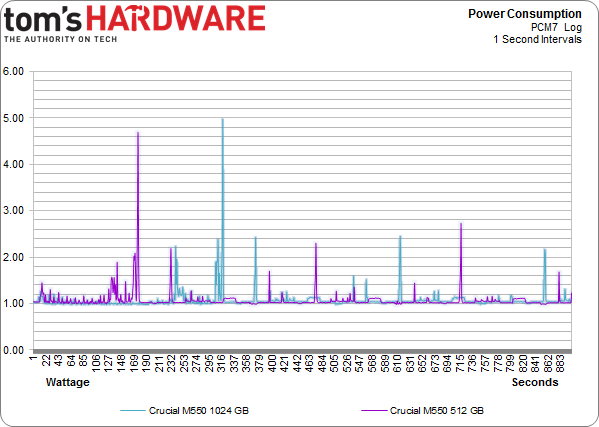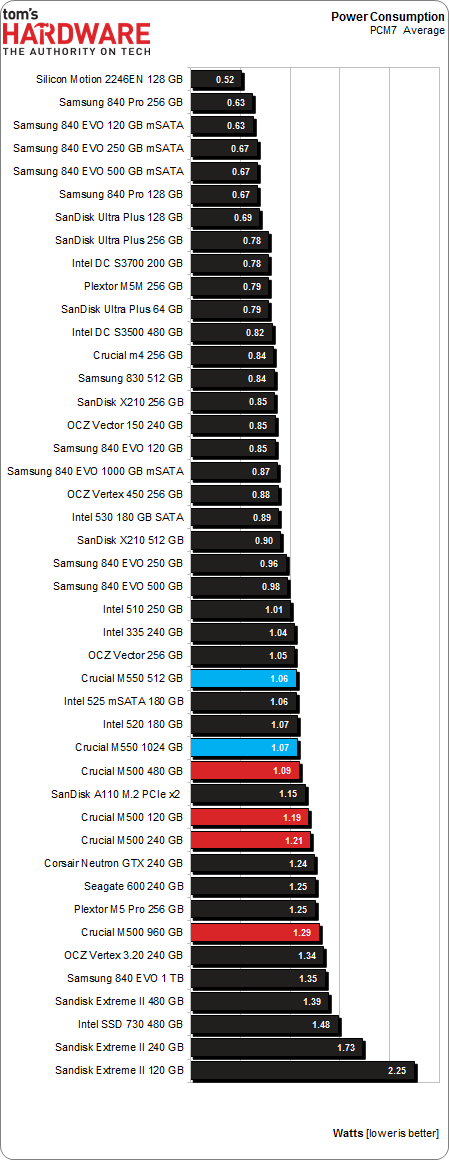The Crucial M550 SSD Review: Striking Back With More Performance
Crucial's M500 brought mainstream performance, enhanced features, and rock-bottom pricing together in one of the most-recommended SSDs of 2013. Following up, Crucial has a refined version called the M550, juiced-up for performance-hungry enthusiasts.
Results: Power Consumption
Idle Power Consumption
Idle consumption is the most important power metric for consumer and client SSDs. After all, solid-state drives complete host commands quickly, and then drop back down to idle. Aside from the occasional background garbage collection, a modern SSD spends most of its life doing very little. Enterprise-oriented drives are more frequently used at full tilt, making their idle power numbers less relevant. But this just isn't the case on the desktop, where the demands of client and consumer computing leave most SSDs sitting on their hands for long stretches of time.
Active idle power numbers are critical, especially when it comes to their impact on mobile platforms. Idle means different things on different systems, though. Pretty much every drive we're testing is capable of one or more low-power states, up to and including DevSleep. That last feature is a part of the SATA 3.2 host specification. And while it requires a capable SSD and a compatible platform, enabling it takes power consumption down to a very small number.
Marvell's 88SS9189 features enhanced power management (at least, that's what Crucial tells us). The improvements don't only affect active idle consumption, either. Partial hibernation and DevSlp are also more efficient. Desktop users aren't going to care much, but given the M500's mediocre power numbers, Crucial needed better performance in this metric to make the M550 a more attractive mobile option.
The M550 does represent forward progress, but it still can't hold a candle to Samsung's efforts. This is the first benchmark where the 840 EVO scores a meaningful victory over the M550.
Take everything that was beautiful about Crucial's M500, add more capacity, and then more performance. The M550 sets its predecessor's shortcomings right. Excessive redundancy and conservative engineering resulted in the M500's modest performance. A year later, the M550 sports an updated controller and firmware, putting it in elite company.
The 512 GB M550 is as quick as the 1024 GB model, but sells for $200 less, making it more palatable to mainstream audiences.
PCMark 7 Average Power Consumption
If we log power consumption through a workload, even a relatively heavy one, we see that average use is still pretty close to the idle numbers. Maximum power may spike fiercely, but the usage seen during a PCMark 7 run is pretty light. You can see the drives fall back down to the idle "floor" between peaks of varying intensity.
Get Tom's Hardware's best news and in-depth reviews, straight to your inbox.
If I knew nothing else about the M550s and was shown this chart, I'd assume that the drives are very fast. There's no real drama to report on; reads and writes are handled quickly before power drops back into the idle range. The spikes don't last long, and the initial few minutes of the benchmark, which sometimes reveal awkward power use, are instead quite clean.
Average power consumption across PCMark 7 represents an improvement over Crucial's 480 and 960 GB M500s. But higher-than-average active idle still hurts the new M550s a bit.
Maximum Observed Power Consumption
Higher-capacity drives use more power under heavy loads. No surprise there.
Current page: Results: Power Consumption
Prev Page Results: TRIM Testing Next Page M550 SSD: Evolving Value Into High Performance-
ikyung Heard rumors of Samsung planning to market the 850 with aggressive pricing this year. Would like to see Crucial and Samsung duke it out in pricing.Reply -
cryan ReplyHeard rumors of Samsung planning to market the 850 with aggressive pricing this year. Would like to see Crucial and Samsung duke it out in pricing.
They already have IMHO. The Samsung 840 EVO is significantly cheaper than it was at launch. It and the M500 have seemed to move in lockstep. Along the way, we've seen other manufacturers follow suit. Even Intel's 530 series, which has been on the more expensive side of mainstream products has been seen for just $140 for the 240 GB version here in the State.Regards,Christopher Ryan -
venk90 INSANELY GOOD DEAL ON AMAZON ! The 512 GB SSD is listed at 169$ incorrectly ! Grab them before they change it. I ordered 20 myself ! Will e-bay all of it or feel bad and return it to Amazon !Reply -
cryan ReplyI just splashed $250 (delivered to Oz) on a M500 480GB mSATA, eh, can't complain.
I hope Crucial continues to sell the M500 right where it is. The deals are just too good, and it'd be truly sad were Crucial/Micron to up the price on us.And they're not slow. I know it seems like they're sub par compared to some of the last few drives we've tested, but the reality is most users are never going to notice the speeds between different SSD models. The only exception is jumping from an older SATA II drive to a modern SATA III SSD. Even then, you'd need solid hardware in the system.Regards,Christopher Ryan -
Ankursh287 M500 available at $240 (amazon)..damn good drive for the price, performance difference between M500 , M550 & 840/840 pro won't visible to normal user.Reply -
Nada190 When I look at SSD's I want price to performance because I won't even notice a difference.Reply -
Drejeck Specifically for gaming which would be the best? All sort of tricks are allowed, from tweaks to samsung's magician (ram caching).Reply -
RedJaron ReplyOf course, we're in the throes of post-launch pricing. In a few weeks, it's possible that the gap between M500 and M500 will narrow.
Typo on the last page. One of those should be 550.
Happy to see Crucial with this update. I'm with a lot of people, you don't see a difference in SSD performance outside benchmarks. Give me something reasonably fast with great durability and I'm sold. With all this talk of the maturing of 20nm manufacturing, I'd love to see an M500 V2 with less overprovisioning.
-
gizmoguru Hay Tom's the chart for Sequential Reads Benchmark is labled "Random Writes", please correctReply



